Following the crucifixion of Jesus, his disciple, James, (according to legend) made a pilgrimage to the Iberian Peninsula to spread the gospel, and when he returned to Judea he was beheaded by King Herod Agrippa I in the year 44AD. His death is detailed in the New Testament. What followed next is not so believable, though seemingly well documented.
Again, according to legend, his body, along with his followers, were brought to the Iberian Peninsula on a rudderless ship made of stone with no sail. Arriving on the northwest coast, they proceeded up the River Ulla to land at Iria Flavia, (modern-day Padron).
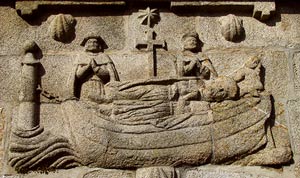
The Celtic Queen Lupia ruled these lands, and when asked by James’ followers if they could bury his body she refused and sent troops after them. The followers of James carried his body across a bridge, but when Lupia's troops tried to cross the bridge it collapsed killing her men.
Queen Lupia then and there decided to convert to Christianity and provided an ox and cart for the followers of James to transport the body. Unsure of where they should bury the sacred remains, his followers prayed and decided to let the ox continue until it chose a place to rest. After pausing at a stream, the ox finally came to rest under an oak tree at the top of a hill, and it is here that they buried the body of James.
James remained undisturbed for the next 760 years until 820 when a group of devotees at a hermitage called Peleo in the forest of Libradón saw miraculous lights in the sky which seemed to fall to earth over a hillock in nearby woods. When the abbot of the hermitage reported this to his bishop, Iria Flavia, the bishop told his superior, Teodomira, who came with an entourage of clerics to witness the events for himself. Over a number of nights, they all watched the stellar display. They cleared the forest over the hillock and began excavating and soon found a stone sepulchre containing three bodies. Teodomira immediately rushed away to tell King Alfonso II about the miracle that he had seen and the bodies that he had found.
Falling stars apart, the area of Santiago de Compostela was known to have been a Roman cemetery around 400, just before the empire began to collapse. It was also used as a cemetery by the Visigoth Suebi tribe when they replaced the Romans in the area, so finding a stone sepulchre there should not have been too surprising. Nevertheless, a new settlement and centre of pilgrimage emerged around the place of the discovery, which had become widely known by 865, and was simply called Compostela from the vulgar Latin for burial ground, compostia tella.
King Alfonso II, whose kingdom was surrounded by the Moors, realised the significance immediately. He needed an icon for his people to rally around, and the discovery of the burial place of St James fitted the bill exactly. The shrewd king ordered the clerics to build a chapel on the site, and legend has it that the king was the first pilgrim to visit the shrine. King Alfonso II had just begun a 23 year campaign against the Caliphate of Córdoba, and though Alfonso died in 842, his successor, Ramiros I, continued the reconquista. He won several battles against the Moors and claimed that it was the spirit of St. James that gave him victory.
This is where myth becomes entangled with the truth again. According to several sources, when Alfonso died, Emir Abd al-Rahman II reinstated an old jizya (a tribute) and demanded that the new king give him 100 virgins, which Ramiros refused to do. This resulted in the two armies supposedly meeting at Clavijo on 23 May 844 where the Christians were outnumbered, but fought valiantly.
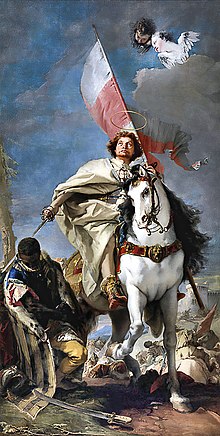
St James at the battle of Clavijo, painted bu Giovanni Batistta Tiepolo.
Depending on which account you read, the year and date of the battle varies, and in truth, neither Christian nor Moorish records of the time contain any mention of the battle. The legend was first written down about 300 years after the supposed event, but the most important part of this fable was that at the peak of the battle, when defeat seemed imminent, some of the soldiers reported seeing a vision of St. James on a white horse brandishing a raised sword leading them to victory. The battle resulted in the death of 500 Moors and earned St James the title of Matamoros; but this invented story is still in the future.
The first church was built at Compostela in AD 829, and by 865 it had become widely known as the resting place of James. But it was the pilgrims who first started to arrive in steady numbers after 899 that changed the fortunes of Compostela. Its growing fame throughout Christendom brought floods of people eager to seek redemption for their sins by suffering the penance of walking all the way to the shrine. The route that they took became well known as the camino and well-worn by the feet of the faithful. To accommodate these religious tourists the camino sprouted hostelries, sanctuaries, shrines and a plethora of priests willing to give absolution – for a price. Compostela became rich on the donations of the fervent and their need for accomodation for the night. Along with its fame as a shrine, the political organisation of the area changed, and several kings of Galicia and León were crowned and anointed by the local bishop at the church, among them King Ordoño IV in 958.
This elevation in importance had not gone unnoticed, and the thought of devotees with money to spend spawned a series of copycat Compostelas; Saint Eulalia in Ovied, and Saint Aemilian in Castile began to compete with Compostela as rulers encouraged their own region-specific cults.
Compostela also attracted a more hostile kind of tourist. Towards the end of the tenth century, Viking raiders frequently attacked Galicia, which was recorded in Nordic sagas as Jackobsland or Gallizaland, and in 968 Bishop Sisenand II was killed by the Vikings whilst defending the town after he had begun the construction of a walled fortress around the sacred tomb and church.
These were lawless times, and the normal way for a king or caliph to increase his wealth or respect was to raid a neighbouring country to rob, pillage and take slaves. With its wealth and fame growing every year, Compostela became a target. In 997 the early church was reduced to ashes by Al-Mansur Ibn Abi Aamir, army commander of the caliph of Córdoba. The al-Andalus commander was accompanied on his raid by his vassal Christian lords, who received a share of the loot, but St James’ tomb and relics were left undisturbed. It was not a vendetta against Christians, but more a series of raids (fifty-seven in total) to enrich his rule and pay for the building of the Shining City near Córdoba. However, the religious significance of Compostela had raised it above all other shrines and construction of the present cathedral began in 1075 in the reign of Alfonso VI of Castile and the patronage of Bishop Diego Peláez. By this time, Compostela had become capital of the Kingdom of Galicia.
 The Cathedral of Compostela
The Cathedral of Compostela
The copycat Compostelas began to multiply and vie each other for recognition. St James’ whole body was allegedly found at Compostela, but the city of Doui in Northern France claimed that his head was there. So did Arras, Samur and Amiens. His hair, meanwhile, was on display at Troyes and Vezelay. Not to be outdone, and prepared to go all the way, Tolouse, Anger and Lorraine all claimed that they had the entire body of St James. But their claims were in vain, because the peregrinos walking along the camino were arriving in ever greater numbers.
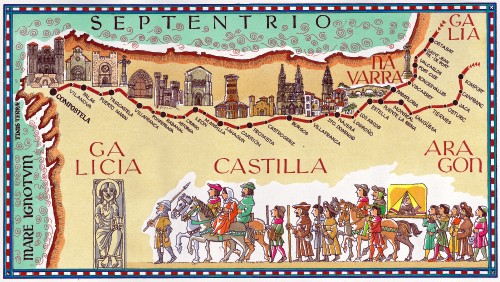
The peregrinos were mostly single minded in that they wanted to reach Compostela. They were not interested in spending time (or money) in any of the towns on the camino, so the wily traders decided that a few miracles along the way might distract them.
One of the first miracles concerned a young German boy travelling with his parents along the camino when they stopped at Santo Domingo de la Calzada for the night. A waitress in the inn fancied the boy who ignored her, and for revenge, she hid a silver cup in his pack then claimed that he stole it. This crime carried the death penalty, and the boy was duly hung. His parents heard a voice saying that their son had been resurrected by Saint Dominic, and they went to the magistrate at Sanitago de Compostela to ask for his body. The magistrate was eating his dinner of roast chicken and rooster at the time, and told the couple that their son was as alive as the chicken that he was eating. The two birds on his plate immediately sprouted feathers, legs and heads and jumped of the plate crowing and clucking.
To this day, in memory of St. Dominic’s miracle, a rooster and chicken with white feathers are kept at the cathedral and are allegedly direct descendants of the original pair. A different rooster and chicken are exchanged each month, and when they are not at the cathedral, are kept in a chicken coop called the Gallinero de Santo Domingo de la Calzada, which the Cofradía de Santo Domingo (Confraternity of Santo Domingo) maintains with the help of donations. There is even a wayside shrine (hornacina) built in 1445 which holds a piece of wood from the gallows from which the boy was hanged.
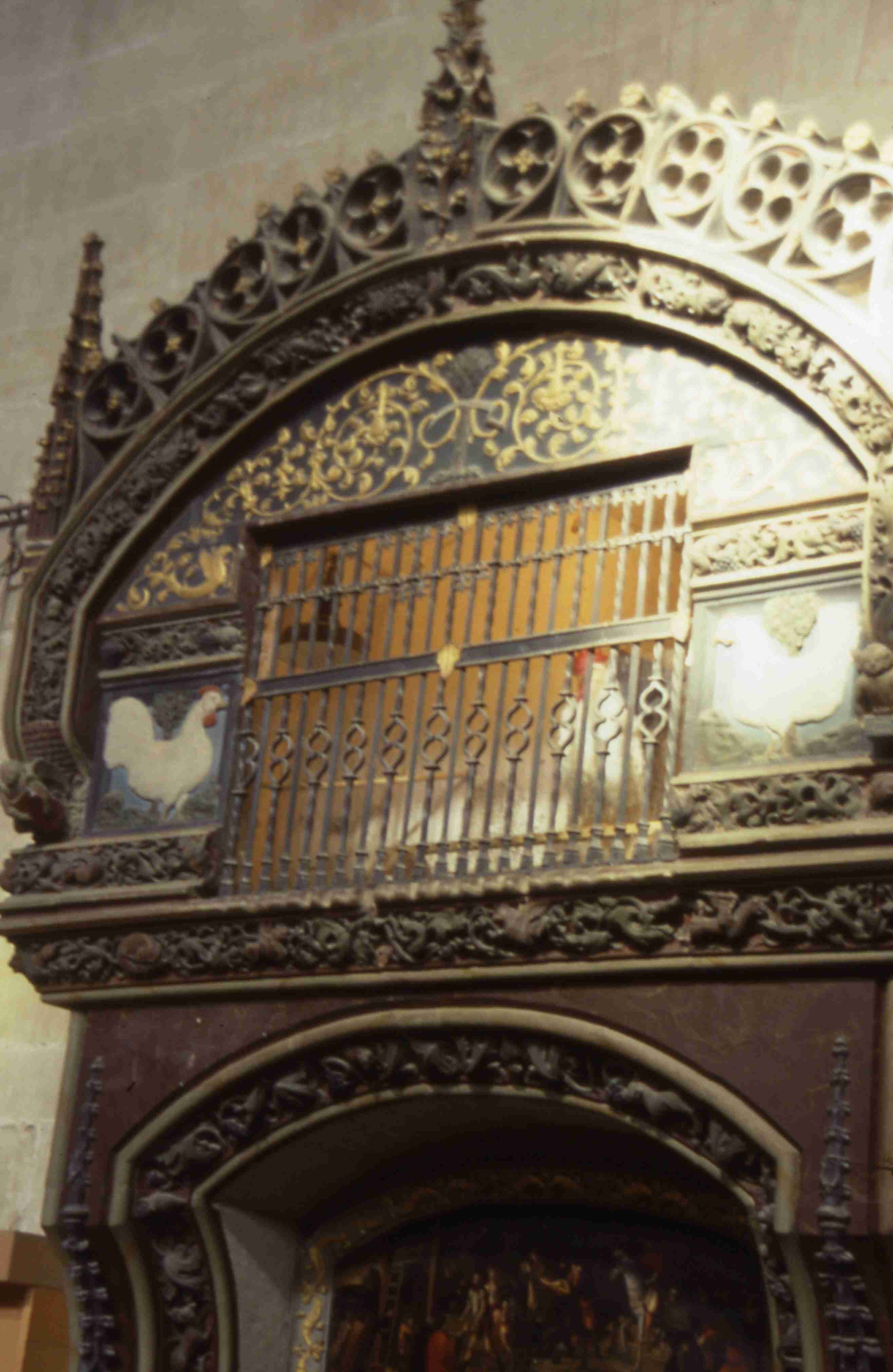
A second miracle occurred at the church of O Cebreiro, when on one particularly cold and windy day, a parishioner from a nearby town came to take mass. The priest, not expecting anybody to turn up, berated the man for risking his health by coming so far on such a day for a little bread and wine. Instantly the bread held by the priest was transformed into the Body of Christ and the wine into his blood. Now called the Miracle of the Holy Grail, the story was spread throughout Europe in the Middle-Ages by the minstrels and the pilgrims of that time. The miraculous chalice and paten are preserved in the church of O Cebreiro, where the remains of both the priest and the peasant rest side by side. The miracle was reinforced in 1486 when Queen Isabel and King Ferdinand, who were in pilgrimage to Santiago de Compostela donated a reliquary to keep and protect the Body and Blood of Christ. Nowadays, you can see the vitrines that preserve the chalice and the paten in the chapel of Santo Milagro de Santa María.
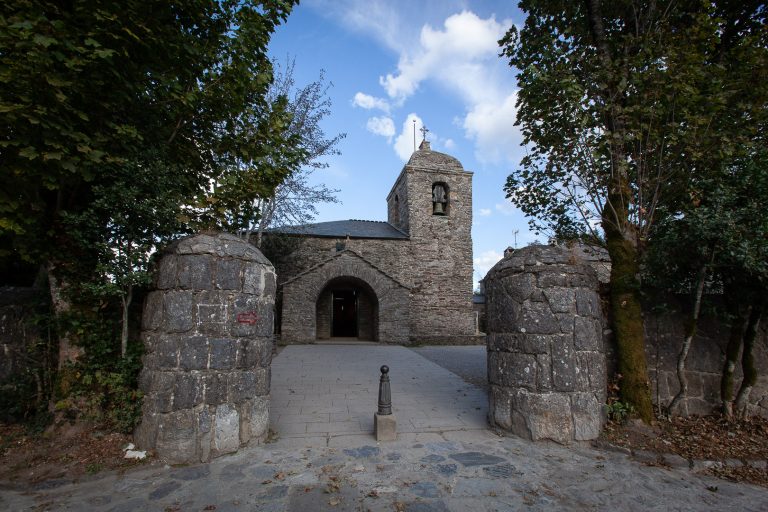 O Cebreiro
O Cebreiro
In the middle of the 14th century the plague stopped the pilgrimages to Santiago; and also the supply of money. This was followed by the reformation, and the power of the Catholic Church began to wane in Europe. But eventually, the pilgrims returned. Very much later, a young Franco watched the arrival of the pilgrims at El Ferrol, his hometown, to walk the 70km. to Compostela. He was not religious, but he realised the enormous power wielded by the church. During the civil war, he tried to control it by choosing his own bishops, but the Vatican overruled him. Not to be outdone, he imprisoned unruly priests in a special priest-only prison in Zamora. During the latter part of his tyranny, Franco tried to unite his country by promoting St. James as Spain’s Patron saint, and for the filming the of El Cid in 1961, he lent several thousand of his soldiers as extras, but the power of St James had waned.
With the death of Franco, and the opening up of Spain, the peregrenos flooded back to the camino in ever greater numbers, giving the north of Spain a much needed economic boost. Covid 19 stopped the influx of tourists for a year, but once again the route is open to people who perhaps want to give thanks for surviving the epidemic.